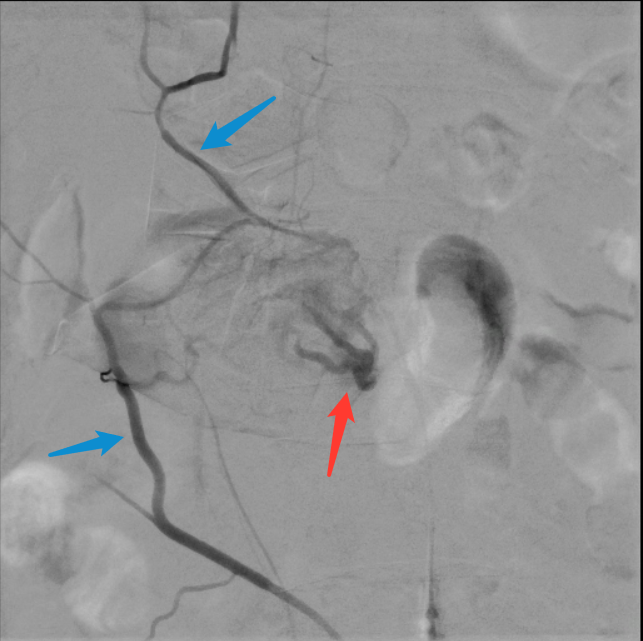Monday Poster Session
Category: Liver
P3948 - Recurrent Peristomal Bleeding at a Urostomy Site Due to Portal Hypertension
Monday, October 27, 2025
10:30 AM - 4:00 PM PDT
Location: Exhibit Hall

Mehak Sachdeva, MBBS
University of Central Florida, HCA Healthcare GME
Ocala, FL
Presenting Author(s)
Mehak Sachdeva, MBBS1, Thomas Brown, MD1, Mustafa Al-Roubaie, MD2
1University of Central Florida, HCA Healthcare GME, Ocala, FL; 2Moffitt Cancer Center, Tampa, FL
Introduction: Portal Hypertensive Enteropathy (PHE) are pathological and mucosal abnormalities seen in the small intestine as a result of portal hypertension. They’re classified into two categories: mucosal inflammatory abnormalities such as erythema or friability and vascular lesions like telangiectasias, or varices. These changes are most commonly seen within gastrointestinal tract; however, rarely can be seen at stomal sites, including colostomies, ileostomies, and rarely urostomies. Here we present a case of urostomy site bleeding in a patient with newly diagnosed portal hypertension.
Case Description/
Methods: A 58-year-old male with a past medical history of bladder cancer, with a permanent urostomy, presented for evaluation after recent hospitalization due to large volume recurrent bleeding from his urostomy site requiring IV iron and transfusions. A CT scan done revealed prominent vasculature at the urostomy. Interventional radiology performed an ultrasound and fluoroscopy-guided venography, confirming the presence of peristomal varices.(Fig.1) Embolosclerotherapy was performed, and the portosystemic pressure gradient was 12 mmHg, consistent with portal hypertension. Subsequent evaluation for portal hypertension was done. Fibroscan revealed advanced fibrosis (F4), confirming the diagnosis cirrhosis, secondary to metabolic dysfunction-associated steatohepatitis (MASH) and chronic alcohol use. Despite initial treatment, the patient continued to have intermittent bleeding. He was started on carvedilol 6.25 mg twice daily which was then uptitrated to 12.5 mg due to continued oozing from the urostomy. He stopped drinking and lost 25 lbs but bleeding persisted. Endoscopy showed non-bleeding small varices in the urostomy, 3cm in from the skin and changes of PHE (Fig.2). Silver nitrate cauterization was done. Plans were made for potential TIPS if bleeding persists.
Discussion: Here we report the first case of urostomy bleeding due to portal hypertension. Parastomal bleeding is a serious potential complication in patients with stomas who also have portal hypertension. Commonly seen at colostomies and ileostomies, urostomy site bleeding represent an even rarer anatomical location for this pathology, with no documented cases described in the literature. Management requires a multidisciplinary approach including non-selective beta-blockers, endoscopic therapy like band ligation, interventional radiology techniques such as sclerotherapy and embolization, and in refractory cases, surgical revision or TIPS.

Figure: Fig 1. Angiography demonstrated varices at the urostomy site (red arrow) with drainage via prominent abdominal wall superficial veins (blue arrows).

Figure: Fig 2. Site of bleeding portal hypertensive enteropathy
Disclosures:
Mehak Sachdeva indicated no relevant financial relationships.
Thomas Brown indicated no relevant financial relationships.
Mustafa Al-Roubaie indicated no relevant financial relationships.
Mehak Sachdeva, MBBS1, Thomas Brown, MD1, Mustafa Al-Roubaie, MD2. P3948 - Recurrent Peristomal Bleeding at a Urostomy Site Due to Portal Hypertension, ACG 2025 Annual Scientific Meeting Abstracts. Phoenix, AZ: American College of Gastroenterology.
1University of Central Florida, HCA Healthcare GME, Ocala, FL; 2Moffitt Cancer Center, Tampa, FL
Introduction: Portal Hypertensive Enteropathy (PHE) are pathological and mucosal abnormalities seen in the small intestine as a result of portal hypertension. They’re classified into two categories: mucosal inflammatory abnormalities such as erythema or friability and vascular lesions like telangiectasias, or varices. These changes are most commonly seen within gastrointestinal tract; however, rarely can be seen at stomal sites, including colostomies, ileostomies, and rarely urostomies. Here we present a case of urostomy site bleeding in a patient with newly diagnosed portal hypertension.
Case Description/
Methods: A 58-year-old male with a past medical history of bladder cancer, with a permanent urostomy, presented for evaluation after recent hospitalization due to large volume recurrent bleeding from his urostomy site requiring IV iron and transfusions. A CT scan done revealed prominent vasculature at the urostomy. Interventional radiology performed an ultrasound and fluoroscopy-guided venography, confirming the presence of peristomal varices.(Fig.1) Embolosclerotherapy was performed, and the portosystemic pressure gradient was 12 mmHg, consistent with portal hypertension. Subsequent evaluation for portal hypertension was done. Fibroscan revealed advanced fibrosis (F4), confirming the diagnosis cirrhosis, secondary to metabolic dysfunction-associated steatohepatitis (MASH) and chronic alcohol use. Despite initial treatment, the patient continued to have intermittent bleeding. He was started on carvedilol 6.25 mg twice daily which was then uptitrated to 12.5 mg due to continued oozing from the urostomy. He stopped drinking and lost 25 lbs but bleeding persisted. Endoscopy showed non-bleeding small varices in the urostomy, 3cm in from the skin and changes of PHE (Fig.2). Silver nitrate cauterization was done. Plans were made for potential TIPS if bleeding persists.
Discussion: Here we report the first case of urostomy bleeding due to portal hypertension. Parastomal bleeding is a serious potential complication in patients with stomas who also have portal hypertension. Commonly seen at colostomies and ileostomies, urostomy site bleeding represent an even rarer anatomical location for this pathology, with no documented cases described in the literature. Management requires a multidisciplinary approach including non-selective beta-blockers, endoscopic therapy like band ligation, interventional radiology techniques such as sclerotherapy and embolization, and in refractory cases, surgical revision or TIPS.

Figure: Fig 1. Angiography demonstrated varices at the urostomy site (red arrow) with drainage via prominent abdominal wall superficial veins (blue arrows).

Figure: Fig 2. Site of bleeding portal hypertensive enteropathy
Disclosures:
Mehak Sachdeva indicated no relevant financial relationships.
Thomas Brown indicated no relevant financial relationships.
Mustafa Al-Roubaie indicated no relevant financial relationships.
Mehak Sachdeva, MBBS1, Thomas Brown, MD1, Mustafa Al-Roubaie, MD2. P3948 - Recurrent Peristomal Bleeding at a Urostomy Site Due to Portal Hypertension, ACG 2025 Annual Scientific Meeting Abstracts. Phoenix, AZ: American College of Gastroenterology.
